The Trend in the Risk of Flash Flood Hazards with Regional Development in the Guanshan River Basin, China
Abstract
1. Introduction
2. Study Area and Data
2.1. Study Area
2.2. Data
3. Methods
3.1. TOPMODEL
3.2. FLO-2D Model
3.3. Risk Assessment Method for Flash Flood Disasters
4. Results
4.1. Designed Flood Estimation
4.2. Flash Flood Disasters Simulation
4.3. Hazard Map of Flash Flood Disasters
4.4. Risk Status Assessment for Flash Flood Disaster
5. Discussion
6. Conclusions
Author Contributions
Funding
Conflicts of Interest
References
- Oruonye, E.D. Socio-economic impact assessment of flash flood in Jalingo metropolis, Taraba State, Nigeria. Int. J. Environ. Sci. 2012, 1, 135–140. [Google Scholar]
- Saber, M.; Hamaguchi, T.; Kojiri, T.; Tanaka, K. Flash flooding simulation using hydrological modeling of wadi basins at nile river based on satellite remote sensing data. Annu. Dis. Prev. Res. Inst. Kyoto Univ. 2010. Available online: https://repository.kulib.kyoto-u.ac.jp/dspace/handle/2433/129361 (accessed on 11 June 2020).
- Sanyal, J.; Lu, X. Remote sensing and GIS-based flood vulnerability assessment of human settlements: A case study of Gangetic West Bengal, India. Hydrol. Process. 2005, 19, 3699–3716. [Google Scholar] [CrossRef]
- Delrieu, G.; Nicol, J.; Yates, E.; Kirstetter, P.-E.; Creutin, J.-D.; Anquetin, S.; Obled, C.; Saulnier, G.-M.; Ducrocq, V.; Gaume, E.; et al. The Catastrophic Flash-Flood Event of 8–9 September 2002 in the Gard Region, France: A First Case Study for the Cévennes–Vivarais Mediterranean Hydrometeorological Observatory. J. Hydrometeorol. 2005, 6, 34–52. [Google Scholar] [CrossRef]
- Špitalar, M.; Gourley, J.J.; Lutoff, C.; Kirstetter, P.-E.; Brilly, M.; Carr, N. Analysis of flash flood parameters and human impacts in the US from 2006 to 2012. J. Hydrol. 2014, 519, 863–870. [Google Scholar] [CrossRef]
- Ruin, I.; Creutin, J.-D.; Anquetin, S.; Lutoff, C. Human exposure to flash floods–Relation between flood parameters and human vulnerability during a storm of September 2002 in Southern France. J. Hydrol. 2008, 361, 199–213. [Google Scholar] [CrossRef]
- Fengqing, J.; Cheng, Z.; Guijin, M.; Ruji, H.; Qingxia, M. Magnification of Flood Disasters and its Relation to Regional Precipitation and Local Human Activities since the 1980s in Xinjiang, Northwestern China. Nat. Hazards 2005, 36, 307–330. [Google Scholar] [CrossRef]
- Balica, S.F.; Douben, N.; Wright, N. Flood vulnerability indices at varying spatial scales. Water Sci. Technol. 2009, 60, 2571–2580. [Google Scholar] [CrossRef]
- Forkuo, E.K. Flood hazard mapping using Aster image data with GIS. Int. J. Geomat. Geosci. 2011, 1, 932–950. [Google Scholar]
- Garrote, J.; Alvarenga, F.; Diez-Herrero, A. Quantification of flash flood economic risk using ultra-detailed stage–damage functions and 2-D hydraulic models. J. Hydrol. 2016, 541, 611–625. [Google Scholar] [CrossRef]
- Vojtek, M.; Vojteková, J. Flood hazard and flood risk assessment at the local spatial scale: A case study. Geomat. Nat. Hazards Risk 2016, 7, 1973–1992. [Google Scholar] [CrossRef]
- Huang, Y. Comparison and Application of Hydrological Models in Mountain Flood Simulation. J. Water Resour. Res. 2019, 8, 33–43. [Google Scholar] [CrossRef]
- Danjiangkou City Suffered a Heavy Rain Disaster. Available online: http://www.hbdjk.com/html/2012-08/76094.html (accessed on 15 August 2018).
- A Catastrophic Flood happened in Liuliping Town and Guanshan Town, Shiyan City, Hubei Province, China, on 6 August 2012. Available online: http://blog.sina.com.cn/s/blog_5e43f42901012a91.html (accessed on 15 August 2018).
- Uysal, M.M.; Toprak, A.; Polat, N. DEM generation with UAV Photogrammetry and accuracy analysis in Sahitler hill. Measurement 2015, 73, 539–543. [Google Scholar] [CrossRef]
- National Bureau of Statistics of China. China Statistical Yearbook (2003–2018); China Statistics Press: Beijing, China, 2006. (In Chinese) [Google Scholar]
- Ambroise, B.; Beven, K.; Freer, J. Toward a Generalization of the TOPMODEL Concepts: Topographic Indices of Hydrological Similarity. Water Resour. Res. 1996, 32, 2135–2145. [Google Scholar] [CrossRef]
- Steers, J.A.; Peel, R.; Chisholm, M.; Haggett, P. Processes in Physical and Human Geography. Geogr. J. 1976, 142, 539. [Google Scholar] [CrossRef]
- Beven, K.J.; Kirkby, M.J. A physically based, variable contributing area model of basin hydrology/Un modèle à base physique de zone d’appel variable de l’hydrologie du bassin versant. Hydrol. Sci. Bull. 1979, 24, 43–69. [Google Scholar] [CrossRef]
- O’Brien, J. FLO-2D Reference Manual, Version 2009. FLO-2D Official Website. Available online: http://www.flo-2d.com (accessed on 6 June 2011).
- Hübl, J.; Steinwendtner, H. Two-dimensional simulation of two viscous debris flows in Austria. Phys. Chem. Earth Part C 2001, 26, 639–644. [Google Scholar] [CrossRef]
- Boniello, M.A.; Calligaris, C.; Lapasin, R.; Zini, L. Rheological investigation and simulation of a debris-flow event in the Fella watershed. Nat. Hazards Earth Syst. Sci. 2010, 10, 989–997. [Google Scholar] [CrossRef]
- Zonensein, J.; Miguez, M.G.; De Magalhães, L.P.C. Flood Risk Index as An Urban Management Tool, 11th ed.; ICUD: Edinburgh, Scotland, 2008. [Google Scholar]
- Nasiri, H.; Shahmohammadi-Kalalagh, S. Flood vulnerability index as a knowledge base for flood risk assessment in urban area. J. Novel Appl. Sci. 2013, 2, 269–272. [Google Scholar]
- Zhang, D.-W.; Quan, J.; Zhang, H.-B.; Wang, F.; Wang, H.; He, X.-Y. Flash flood hazard mapping: A pilot case study in Xiapu River Basin, China. Water Sci. Eng. 2015, 8, 195–204. [Google Scholar] [CrossRef]
- Beffa, C. Two-Dimensional Modelling of Flood Hazards in Urban Areas, 3rd ed.; Brandenbur University of Technology: Berlin, Germany, 1998. [Google Scholar]
- FLO-2D Software, Inc. FLO-2D Mapper Manual Pro, Version 2017. FLO-2D Official Website. Available online: http://www.flo-2d.com (accessed on 25 November 2018).
- Loat, R.; Petrascheck, A. Prise en compte des dangers dus aux crues dans le cadre des activités de l’aménagement du territoire. Recommandations, dangers naturels. Office fédéral de l’économie des eaux (OFEE), Office fédéral de l’aménagement du territoire (OFAT), Office fédéral de l’environnement (OFEFP), des forêts et du paysage. 1997. Available online: http://www.planat.ch/de/suche/?tx_indexedsearch%5Bsword%5D=Loat%2C+R.%3B+Petrascheck%2C+A (accessed on 28 March 2019).
- National Flash Flood Disaster Prevention Project Team of China. Technical Requirements for Analysis and Evaluation of Flash Flood Disasters. Douding Construction Network. Available online: http://jz.docin.com/p-1237230452.html.2014-08 (accessed on 23 April 2019).
- Wen, J.B. Regulations on the Prevention and Control of Geological Hazards in China. Bull. People’s Gov. Henan Prov. 2004, 7, 2–56. [Google Scholar]
- Zhan, D.J.; Xu, X.Y.; Chen, Y.F. Engineering Hydrology, 4th ed.; China Water & Power Press: Tianjin, China, 2010. [Google Scholar]
- Sun, J.C.; Zhang, J.Y.; Wang, J. Standard for Hydrological Information and Hydrological Forecasting; Chinese Standard; Chinese Ministry of Water Resources: Beijing, China, 2008.
- Guo, J. Hydrological Model of Guanshan River Basin Based on Mixed Runoff Model. Master’s Thesis, Wuhan University, Wuhan, China, 2019. [Google Scholar]
- Campling, P.; Gobin, A.; Beven, K.; Feyen, J. Rainfall-runoff modelling of a humid tropical catchment: The TOPMODEL approach. Hydrol. Process. 2002, 16, 231–253. [Google Scholar] [CrossRef]
- Zhao, X. Hydraulics, 1st ed.; China Electric Power Press: Beijing, China, 2009. [Google Scholar]
- FLO-2D Software, Inc. Data Input Manual PRO, Version 2016. FLO-2D Official Website. Available online: http://www.flo-2d.com (accessed on 25 November 2018).
- Haltas, I.; Tayfur, G.; Elçi, Ş. Two-dimensional numerical modeling of flood wave propagation in an urban area due to Ürkmez dam-break, İzmir, Turkey. Nat. Hazards 2016, 81, 2103–2119. [Google Scholar] [CrossRef]
- Apel, H.; Aronica, G.T.; Kreibich, H.; Thieken, A. Flood risk analyses—how detailed do we need to be? Nat. Hazards 2008, 49, 79–98. [Google Scholar] [CrossRef]
- Hsu, S.M.; Chiou, L.B.; Lin, G.-F.; Chao, C.H.; Wen, H.Y.; Ku, C.-Y. Applications of simulation technique on debris-flow hazard zone delineation: A case study in Hualien County, Taiwan. Nat. Hazards Earth Syst. Sci. 2010, 10, 535–545. [Google Scholar] [CrossRef]
- Calligaris, C.; Boniello, M.A.; Zini, L. Debris flow modelling in Julian Alps using FLO-2D. Debris Flow 08 2008, 60, 81–88. [Google Scholar] [CrossRef]
- Kourgialas, N.; Karatzas, G.P. Flood management and a GIS modelling method to assess flood-hazard areas—A case study. Hydrol. Sci. J. 2011, 56, 212–225. [Google Scholar] [CrossRef]
- Merz, B.; Elmer, F.; Thieken, A. Significance of “high probability/low damage” versus “low probability/high damage” flood events. Nat. Hazards Earth Syst. Sci. 2009, 9, 1033–1046. [Google Scholar] [CrossRef]
- Nadal, N.C.; Zapata, R.E.; Pagán, I.; Lopez, R.; Agudelo, J. Building Damage due to Riverine and Coastal Floods. J. Water Resour. Plan. Manag. 2010, 136, 327–336. [Google Scholar] [CrossRef]

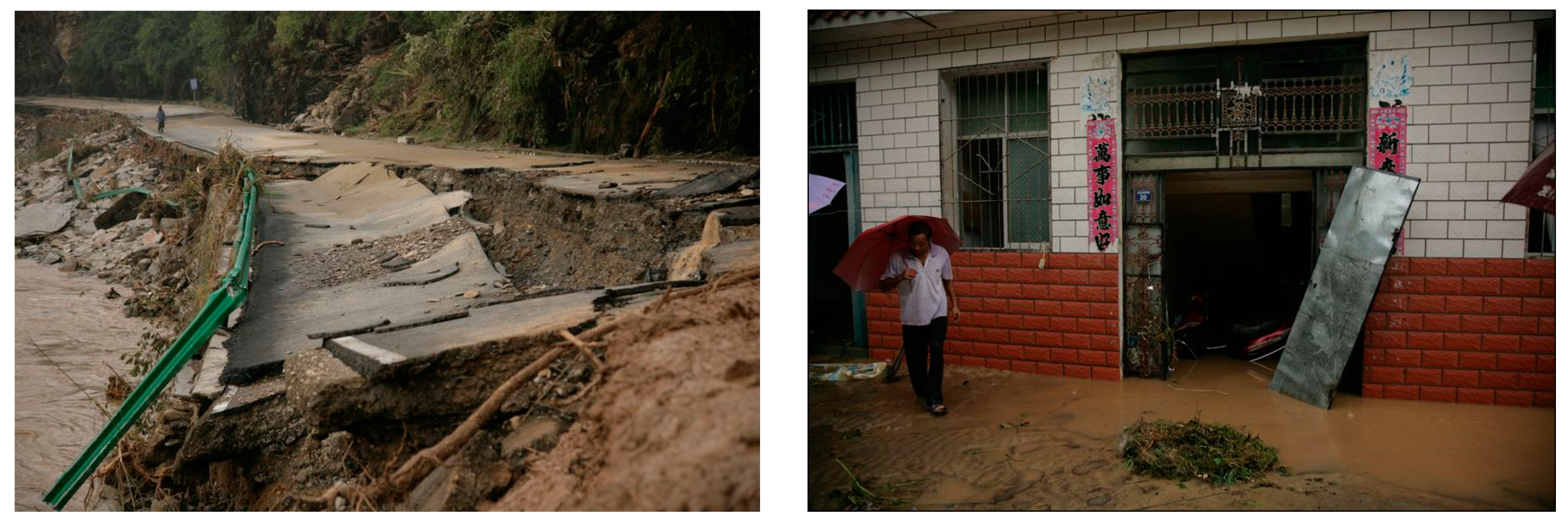
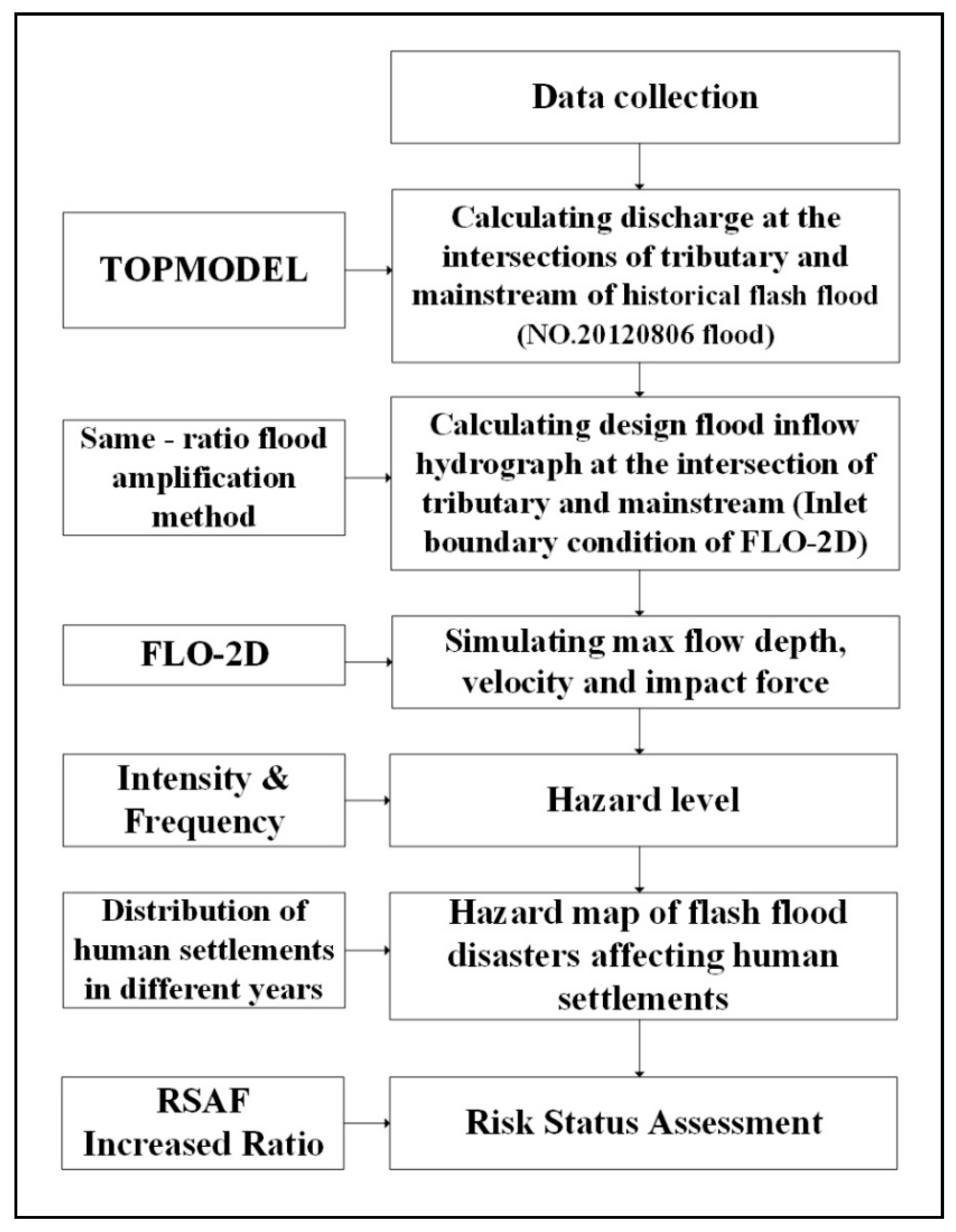
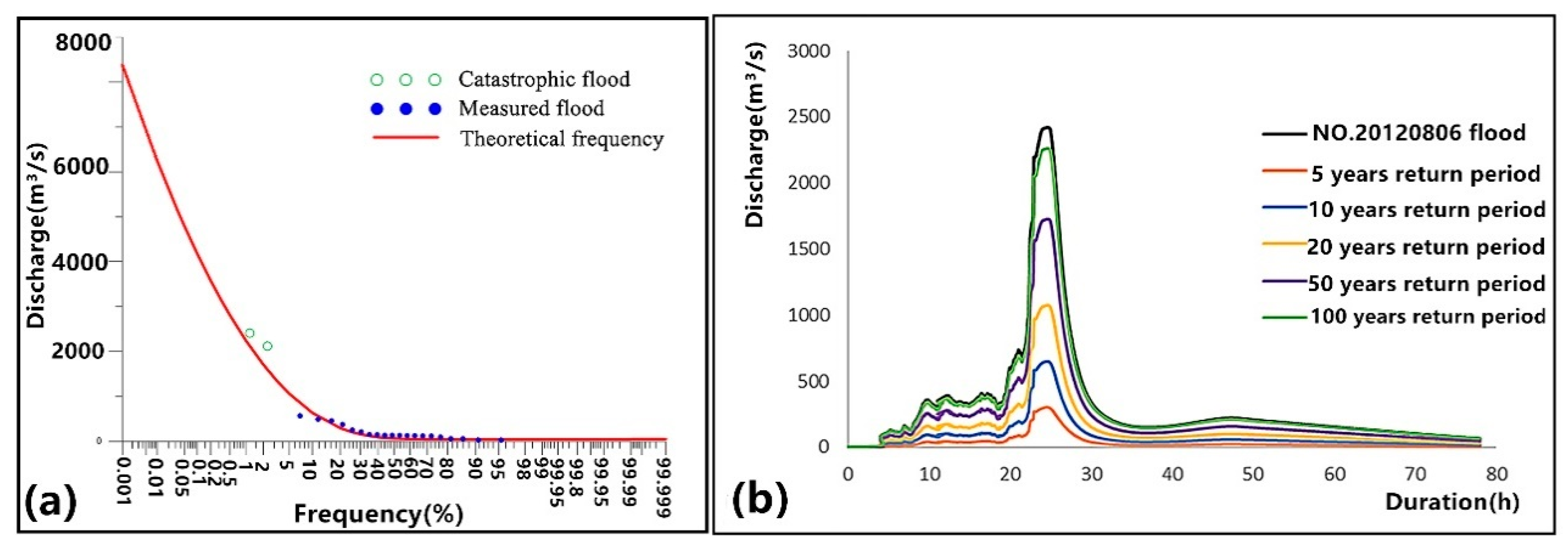
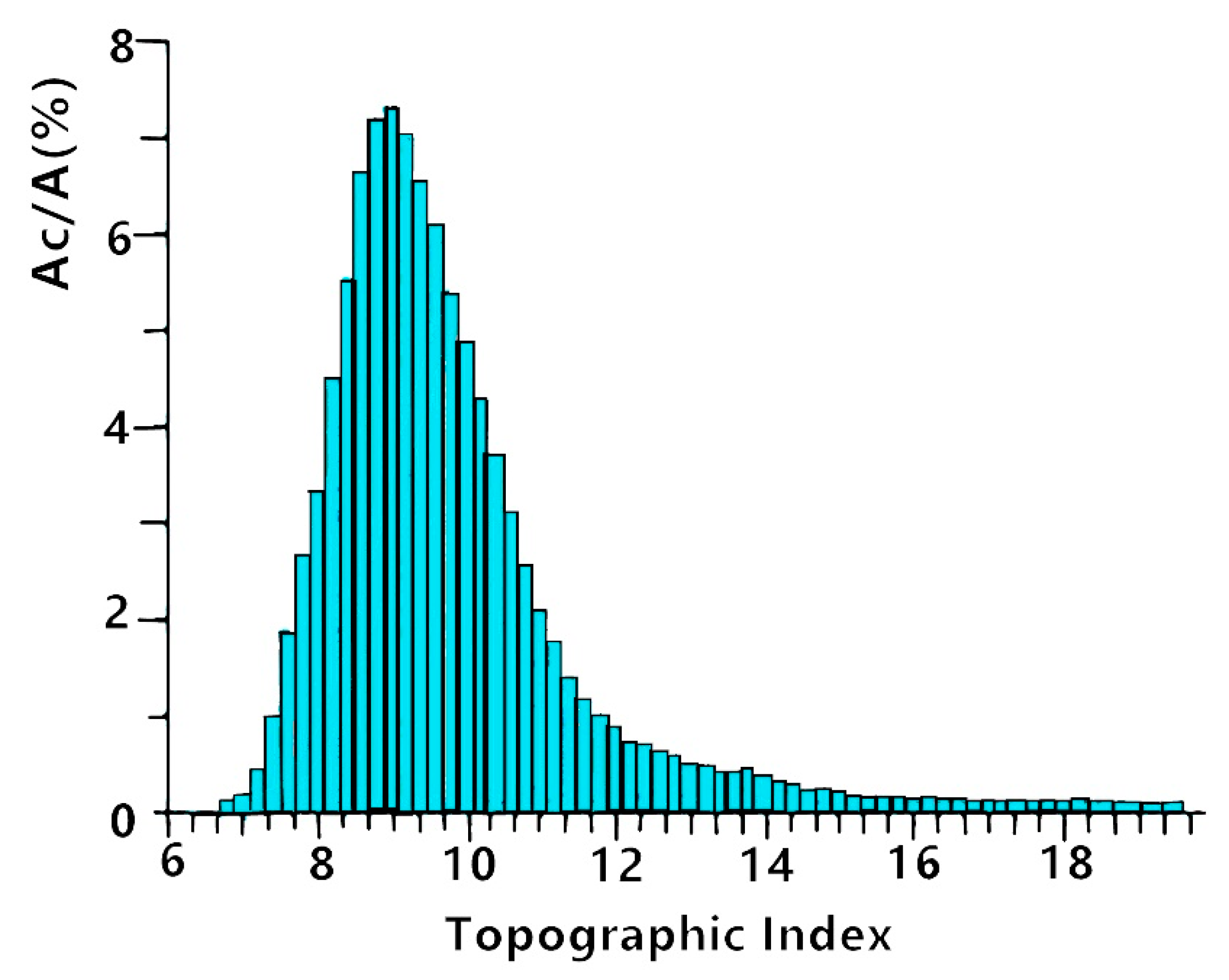

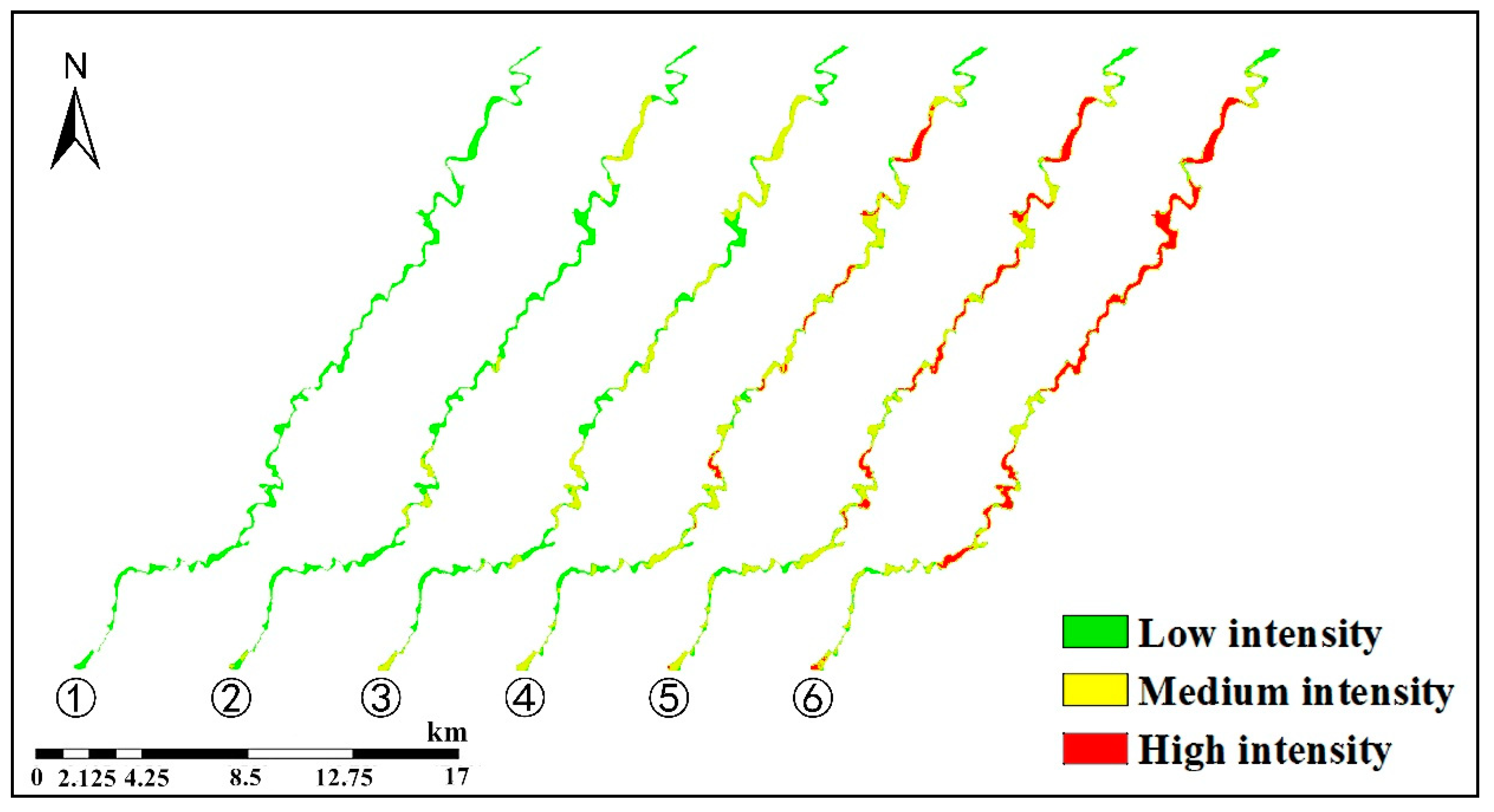
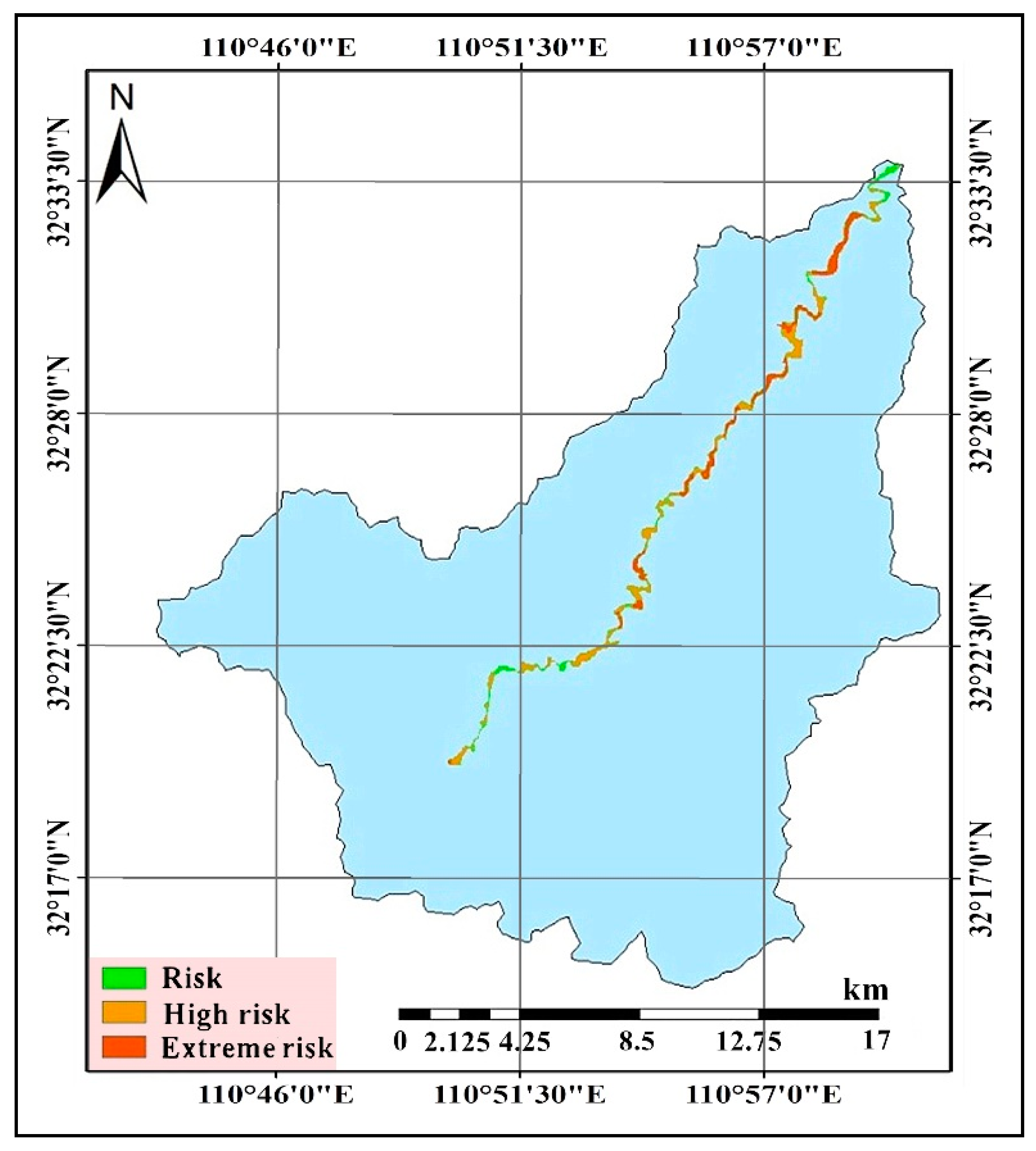


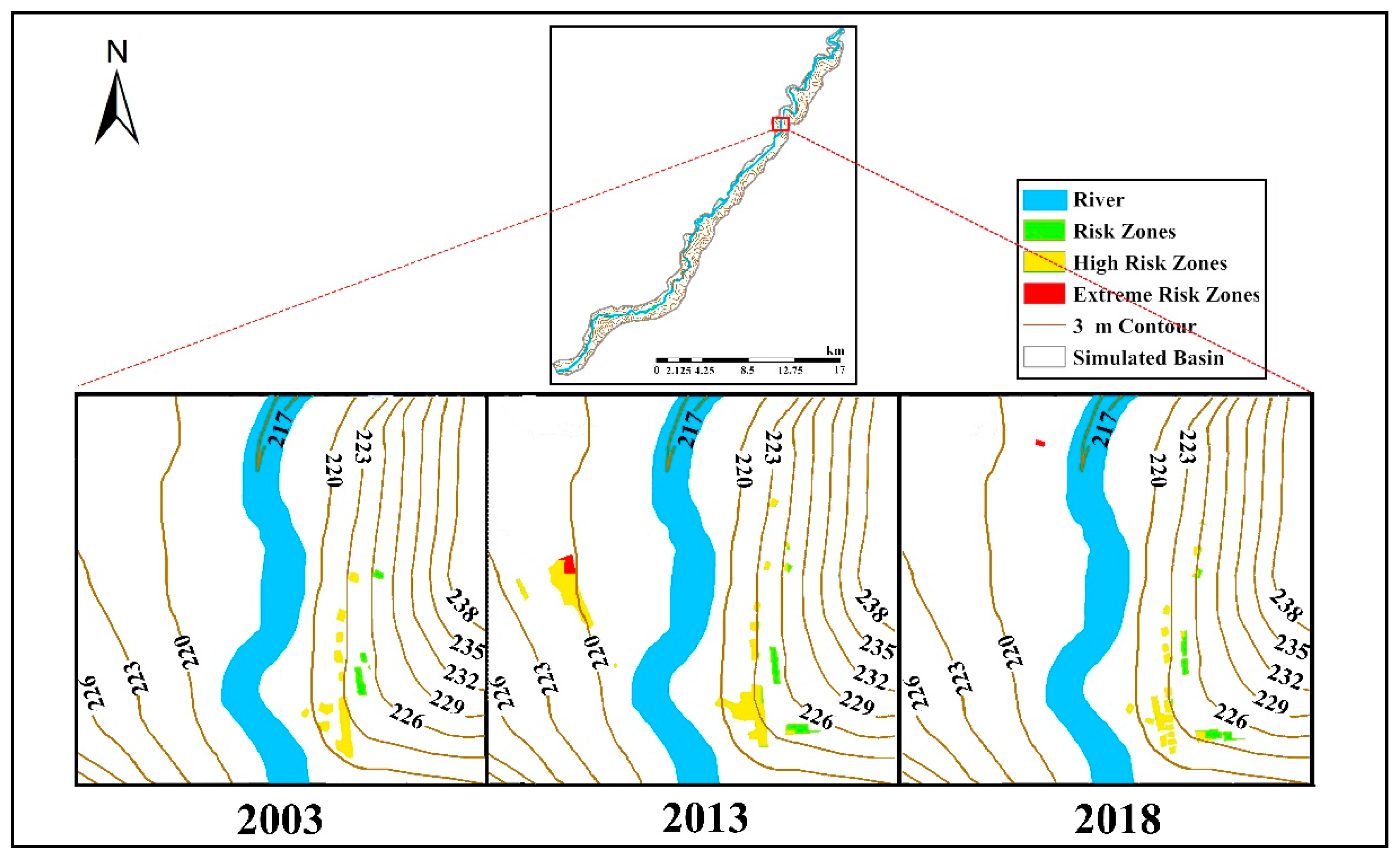
| Accident Positions | Measured Max Low Depth (m) | Disaster Situation | Disaster Degree |
|---|---|---|---|
| 1 | 4.94 | House flooded about 6 m; two deaths | Extreme Risk |
| 2 | 5.09 | A department of highway management was destroyed; one death | Extreme Risk |
| 3 | 3.55 | Water submerged to the bridge arch | High Risk |
| 4 | 4.35 | House flooded about 1.2 m | Extreme Risk |
| 5 | 4.06 | House flooded about 0.8 m | Extreme Risk |
| 6 | 5.38 | House flooded | Extreme Risk |
| 7 | 1.27 | House flooded | Risk |
| Peak Discharge of Typical Flood (m3/s) | Return Period of Designed Flood | Peak Discharge of Designed Flood (m3/s) | Magnification Factor |
|---|---|---|---|
| 2410 (5 August 2012) | 5-year | 295.56 | 0.123 |
| 10-year | 633.92 | 0.263 | |
| 20-year | 1061.40 | 0.440 | |
| 50-year | 1712.70 | 0.711 | |
| 100-year | 2248.61 | 0.933 |
| Period | Flood Number (DDMMYYYY) | Error of Runoff Volume (%) | Peak Discharge Error (%) | Difference in Time between Simulated and Observed Peak Occurrence (Hour) | NSE |
|---|---|---|---|---|---|
| Calibration | 19042009 | 17.42 | 20.00 | 0 | 0.84 |
| 27052009 | 45.90 | 33.66 | 1 | 0.30 | |
| 08062010 | 44.77 | 41.35 | 0 | 0.70 | |
| 19072010 | 25.32 | 26.18 | 0 | 0.77 | |
| 02082010 | 1.98 | 2.39 | 1 | 0.88 | |
| 25082010 | 30.15 | 39.73 | 0 | 0.71 | |
| 06092010 | 36.12 | 15.22 | 0 | 0.79 | |
| 19092010 | 26.80 | 35.26 | 0 | 0.83 | |
| 10072012 | 32.89 | 49.98 | 0 | 0.66 | |
| 06082012 | 18.91 | 13.97 | 0 | 0.93 | |
| 21082012 | 1.64 | 26.18 | 0 | 0.78 | |
| 11092012 | 15.06 | 21.90 | 0 | 0.50 | |
| Average | 24.75 | 27.15 | 0.17 | 0.72 | |
| Validation | 18092014 | 12.14 | 4.66 | 0 | 0.98 |
| 28092014 | 15.79 | 21.80 | 1 | 0.79 | |
| 202102014 | 8.85 | 19.53 | 0 | 0.92 | |
| 06042015 | 28.31 | 1.01 | 0 | 0.53 | |
| 09082015 | 4.58 | 13.04 | 0 | 0.78 | |
| 19082015 | 19.00 | 16.13 | 1 | 0.94 | |
| Average | 14.78 | 12.70 | 0.33 | 0.82 |
| T0 | td | Srmax | Ks | f0 | fc | k | n | |
|---|---|---|---|---|---|---|---|---|
| 0.597 | 3.816 | 0.680 | 1.387 | 0.437 | 15.885 | 5.832 | 3.478 | 3.766 |
| Accident Positions | Simulated Max Velocity (m/s) | Simulated Max Impact Force (MN/m) | Simulated Max Flow Depth (m) | Measured Max Water Depth (m) | Percent Error (%) |
|---|---|---|---|---|---|
| 1 | 5.42 | 7.00 | 4.98 | 4.94 | 0.96 |
| 2 | 5.36 | 6.33 | 5.06 | 5.09 | 0.59 |
| 3 | 0.82 | 0.12 | 3.52 | 3.55 | 1.02 |
| 4 | 4.61 | 3.25 | 4.41 | 4.35 | 1.29 |
| 5 | 3.44 | 1.78 | 4.00 | 4.06 | 1.50 |
| 6 | 6.19 | 8.65 | 5.46 | 5.38 | 1.48 |
| 7 | 1.20 | 0.09 | 1.30 | 1.27 | 2.53 |
| Flood Level | Flood Intensity | Maximum Depth h (m) | Relationship | Maximum Discharge per Unit Width q (m2/s) |
|---|---|---|---|---|
| 1 | Low | 0 < h < 1 m | And | 0 < q < 2 m2/s |
| 2 | Medium | 1 ≤ h < 2.5 m | Or | 2 ≤ q < 10 m2/s |
| 3 | High | h ≥ 2.5 m | Or | q ≥ 10 m2/s |
| Flood Type | Percentage of Low Intensity (%) | Percentage of Medium Intensity (%) | Percentage of High Intensity (%) | Total Area (km2) |
|---|---|---|---|---|
| No. 20120806 flood | 20.49 | 31.09 | 48.42 | 7.17 |
| 5-year return period | 99.68 | 0.32 | 0.00 | 6.58 |
| 10- year return period | 79.94 | 20.06 | 0.00 | 6.22 |
| 20-year return period | 57.86 | 42.14 | 0.00 | 5.67 |
| 50-year return period | 33.28 | 51.56 | 15.16 | 5.17 |
| 100-year return period | 26.06 | 45.64 | 28.30 | 4.51 |
| Hazard Level | Flood Return Period (Years) | Frequency | Area (km2) | Percentage of the Total Area of Hazard Zones (%) | Percentage of the Area of the Simulated Basin (%) |
|---|---|---|---|---|---|
| Risk | 100 | Low | 1.72 | 25.99 | 10.52 |
| High risk | 20 | Medium | 3.02 | 45.74 | 18.47 |
| Extreme risk | 5 | High | 1.87 | 28.28 | 11.44 |
| Total area of simulated basin | 16.35 | ||||
| Year | Hazard Area (m2) | RSAF | Increased Ratio | |||||||
|---|---|---|---|---|---|---|---|---|---|---|
|
Hazard Level | 2003 | 2013 | 2018 | 2003 | 2013 | 2018 | 2003 to 2013 | 2003 to 2018 | 2013 to 2018 | |
| Risk | 13,416 | 38,210 | 36,133 | 0.05 | 0.15 | 0.14 | 185% | 169% | −5% | |
| High risk | 38,141 | 72,261 | 57,571 | 0.73 | 1.38 | 1.10 | 89% | 51% | −20% | |
| Extreme risk | 9564 | 29,283 | 24,700 | 0.37 | 1.12 | 0.94 | 206% | 158% | −16% | |
| All | 61,121 | 139,754 | 118,404 | 1.15 | 2.65 | 2.18 | ||||
© 2020 by the authors. Licensee MDPI, Basel, Switzerland. This article is an open access article distributed under the terms and conditions of the Creative Commons Attribution (CC BY) license (http://creativecommons.org/licenses/by/4.0/).
Share and Cite
Chen, N.; Zhang, Y.; Wu, J.; Dong, W.; Zou, Y.; Xu, X. The Trend in the Risk of Flash Flood Hazards with Regional Development in the Guanshan River Basin, China. Water 2020, 12, 1815. https://doi.org/10.3390/w12061815
Chen N, Zhang Y, Wu J, Dong W, Zou Y, Xu X. The Trend in the Risk of Flash Flood Hazards with Regional Development in the Guanshan River Basin, China. Water. 2020; 12(6):1815. https://doi.org/10.3390/w12061815
Chicago/Turabian StyleChen, Ningyue, Yanjun Zhang, Jinjin Wu, Wenxun Dong, Yixuan Zou, and Xin Xu. 2020. "The Trend in the Risk of Flash Flood Hazards with Regional Development in the Guanshan River Basin, China" Water 12, no. 6: 1815. https://doi.org/10.3390/w12061815
APA StyleChen, N., Zhang, Y., Wu, J., Dong, W., Zou, Y., & Xu, X. (2020). The Trend in the Risk of Flash Flood Hazards with Regional Development in the Guanshan River Basin, China. Water, 12(6), 1815. https://doi.org/10.3390/w12061815







